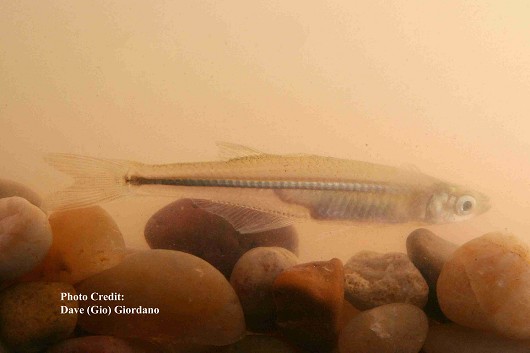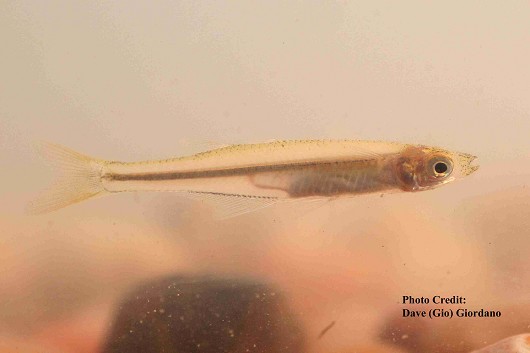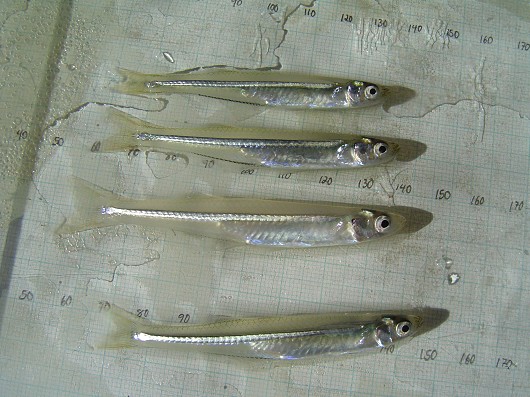Mississippi silversides
-
Scientific NameMenidia beryllina subspecies
-
NativeNo
-
Identification
 Mississippi silverside approximately 8 cm (3”) long. Location: Suisun Marsh, California Date: 8/8/2008
Mississippi silverside approximately 8 cm (3”) long. Location: Suisun Marsh, California Date: 8/8/2008 Mississippi silverside approximately 9 cm (3.5”) long. Location: Suisun Marsh, California Date: 8/6/2007
Mississippi silverside approximately 9 cm (3.5”) long. Location: Suisun Marsh, California Date: 8/6/2007 Mississippi silverside, captured in rotary screw trap on Sacramento River at Knight's Landing. Photo by Dan Worth, California Department of Fish and Game.
Mississippi silverside, captured in rotary screw trap on Sacramento River at Knight's Landing. Photo by Dan Worth, California Department of Fish and Game.- Elongate and slender bodies with large eyes, oblique mouths and pointed heads flattened on top
- Yellowish on the back with a silvery band on each side and translucent green underside
- Pigment spots outline the upper row of scales and form two rows on the caudal peduncle between the anal and caudal fins
- Two dorsal fins widely separated with 4-5 weak spines in the first and 1 spine and 8-9 rays in the second
- Sickle shaped anal fin with 1 spine and 16-18 rays
- 36-44 scales on the lateral line
-
Life History
Mississippi silversides are most common in shallow, warmwater lakes, reservoirs, and estuaries. They school here in very large numbers, concentrated near protected areas with sand or gravel bottoms. Temperatures between 20°C and 25°C are preferred but Mississippi silversides have been found in waters as cold as 8°C and as warm as 34°C. They can also withstand salinities up to 33 ppt, but 15 ppt is the optimal salinity for larval growth. This hardiness allows them to do well in disturbed areas with heavy amounts of agricultural pollution. Schools are organized by size and make dramatic group movements within a lake circling each other in patterns or crossing over one another with no mixing of the two sizes. Feeding occurs in deep water but Mississippi silversides are a common prey choice and will quickly return to shallow areas for protection. Zooplankton is their main prey followed by copepods and cladocreans and peek feeding hours are 1 to 3 hours after daybreak and just before dusk.
Spawning occurs any time of the day in April-September when temperatures are between 15°C and 30°C. Groups of males wait in beds of aquatic vegetation for a school of females to pass and then chase after a single or pair of females. The males will nip at her swollen abdomen until she settles into the vegetation bed where the group quivers violently and releases eggs and milt together. The eggs are attached to the substrate and stay there on their own until they hatch 4-30 days later. The young are planktonic for several weeks until they join a larger school. They will grow to 8-10 cm in their first year and most die immediately after spawning in their 1st or 2nd summer. A single female could produce 200-2,000 eggs per day for 3 months in proper conditions but most die before that 3 month time is complete.
-
Links to Other ResearchN / A


